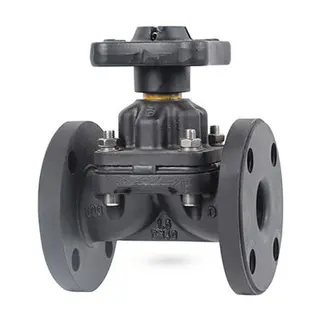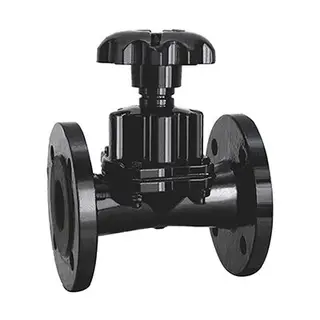Weir Diaphragm Valves vs. Straight-Through Diaphragm Valves
In the industrial field, diaphragm valves, as an important control element, are widely used in various fluid control occasions. Diaphragm valves, with their unique structure and performance advantages, play a key role in industries such as chemical, pharmaceutical, food, and water treatment. Among them, weir diaphragm valves and straight-through diaphragm valves, as the two main types of diaphragm valves, each have their characteristics and applicable scenarios. This article provides a detailed comparison of these two types of diaphragm valves to help you better choose the appropriate valve type.
Introduction to Weir Diaphragm Valves
The valve body flow path of a weir diaphragm valve has a ridge-shaped structure, which forms a sealing pair with the diaphragm. When the valve is closed, the diaphragm presses on the ridge-shaped structure, cutting off the flow of the medium. This design makes the diaphragm valve stroke shorter, thereby reducing the stress and strain on the diaphragm and extending its service life.

1. Performance Advantages of Weir Diaphragm Valves
Short stroke, higher flow resistance: The short stroke of weir diaphragm valves means that the diaphragm experiences less stress during operation, resulting in a longer service life. Although the flow resistance is relatively high, in many application scenarios, this design can effectively protect the diaphragm and reduce maintenance costs.
Low flexibility requirement for diaphragm: Due to the short stroke, the diaphragm does not need to bend excessively, so the flexibility requirements of the diaphragm material are lower. This allows weir diaphragm valves to use a wider range of materials, such as PTFE, further improving corrosion resistance and the ability to handle media with particles.
Reliable sealing, low cost: The sealing performance of weir diaphragm valves is very reliable, and due to the simple structure, manufacturing costs are relatively low. This is a significant advantage for applications with limited budgets and high sealing requirements.
Good corrosion resistance and particle-handling capability: The valve body of weir diaphragm valves can use various materials, such as plastic lining, rubber lining, or enamel lining, giving it excellent corrosion resistance and particle-handling capability. This allows it to adapt to various complex conditions, such as media containing particles and corrosive media.
Suitable for vacuum environments: Weir diaphragm valves can be used in vacuum environments, but under high vacuum conditions, the diaphragm requires special reinforcement. This capability gives it an irreplaceable position in some specialized industrial applications.
2. Application Scenarios of Weir Diaphragm Valves
Because of its structure and performance characteristics, weir diaphragm valves are widely used in the chemical, pharmaceutical, food, and water treatment industries. They are especially suitable for occasions requiring high sealing performance and corrosion resistance, such as handling media containing particles and corrosive substances. In addition, their application in vacuum environments also makes them indispensable in some specialized industrial fields.
Introduction to Straight-Through Diaphragm Valves
The fluid passage of a straight-through diaphragm valve is approximately linear. When the valve opens, the diaphragm lifts, allowing fluid to flow freely in any direction. When the valve is closed, the diaphragm seals tightly, ensuring absolute closure even when there is sand or fibers in the pipeline. This design results in lower flow resistance and better flow capacity.

1. Performance Advantages of Straight-Through Diaphragm Valves
Low flow resistance, longer stroke: The nearly straight fluid path of straight-through diaphragm valves results in lower flow resistance and better flow capacity. This gives it an advantage in applications requiring high flow. However, the longer stroke also means higher flexibility requirements for the diaphragm.
Excellent shut-off and flow performance: The diaphragm of straight-through diaphragm valves can seal tightly when closed, ensuring absolute closure even when there is sand or fibers in the pipeline. This makes it perform excellently in applications requiring high shut-off performance.
Corrosion resistance and particle accommodation: The inner cavity of straight-through diaphragm valves can be lined with plastic, rubber, or enamel, giving it good corrosion resistance and particle-handling capability. This allows it to adapt to various complex conditions, such as media containing particles and corrosive substances.
Suitable for high vacuum environments: Straight-through diaphragm valves can also be used in high vacuum environments. However, since the diaphragm is made of highly elastic material and has a larger area, under high vacuum conditions, the diaphragm may expand into the flow path. To prevent diaphragm collapse, the valve cover must move upward to balance the pressure on the diaphragm.
2. Application Scenarios of Straight-Through Diaphragm Valves
Because of its structure and performance characteristics, straight-through diaphragm valves are widely used in the chemical, pharmaceutical, food, and water treatment industries. They are particularly suitable for occasions requiring high flow and high shut-off performance, such as handling media containing particles and corrosive substances. In addition, their application in high vacuum environments also makes them indispensable in certain specialized industrial fields.
Comparison Between Weir and Straight-Through Diaphragm Valves
After understanding the characteristics of weir and straight-through diaphragm valves, we now directly compare the two to see their differences.
1. Diaphragm Valves Structural Comparison
Weir diaphragm valve: The valve body flow path has a ridge-shaped structure, and the diaphragm presses on it to cut off medium flow. This design results in a shorter diaphragm stroke, reducing diaphragm stress and strain.
Straight-through diaphragm valve: The fluid path is approximately linear, and the diaphragm lifts when the valve opens, allowing fluid to flow freely in any direction. This design results in lower flow resistance and better flow capacity.
2. Diaphragm Valves Performance Comparison
Flow resistance: Weir diaphragm valves have higher flow resistance but a shorter stroke, resulting in lower diaphragm stress. Straight-through diaphragm valves have lower flow resistance, better flow capacity, but a longer stroke, requiring higher diaphragm flexibility.
Diaphragm life: The diaphragm of weir diaphragm valves has a longer life because it experiences less stress during operation. The diaphragm of straight-through diaphragm valves has a relatively shorter life due to higher flexibility requirements.
Sealing performance: Weir diaphragm valves have very reliable sealing and relatively low manufacturing costs due to their simple structure. Straight-through diaphragm valves also provide excellent sealing, but the diaphragm material requirements are higher.
Corrosion and particle resistance: Both types have good corrosion and particle-handling capabilities, but weir diaphragm valves allow a wider selection of materials, such as PTFE.
Applicable environment: Weir diaphragm valves can be used in vacuum environments, but require special reinforcement under high vacuum conditions. Straight-through diaphragm valves can also be used in high vacuum, but diaphragm expansion must be considered.
3. Diaphragm Valves Application Comparison
Weir diaphragm valve: Suitable for applications requiring high sealing and corrosion resistance, such as handling media containing particles and corrosive substances. Its vacuum capability also makes it indispensable in some specialized industrial fields.
Straight-through diaphragm valve: Suitable for applications requiring high flow and high shut-off performance, such as handling media containing particles and corrosive substances. Its high-vacuum capability also makes it irreplaceable in certain specialized industrial fields.
Selection Recommendations
When selecting a diaphragm valve, the choice between a weir diaphragm valve and a straight-through diaphragm valve should be based on the specific application and requirements. The following are some selection suggestions.
1. Consider Flow Resistance and Flow Capacity
If the application requires high flow and diaphragm life is not a critical concern, a straight-through diaphragm valve may be a better choice. Its lower flow resistance and better flow capacity can meet high flow requirements.
2. Consider Diaphragm Life
If the application demands a longer diaphragm life and the flow requirement is moderate, a weir diaphragm valve may be a better choice. Its short stroke reduces diaphragm stress, extending service life.
3. Consider Sealing Performance
If the application requires extremely high sealing performance and handling media containing particles and corrosive substances, a weir diaphragm valve may be a better choice. It offers very reliable sealing and a wider range of material options to adapt to complex conditions.
4. Consider Applicable Environment
If the application involves use in a vacuum environment, both types can be considered. However, for high vacuum, weir diaphragm valves require special reinforcement, while straight-through diaphragm valves require attention to diaphragm expansion.
Conclusion
Weir and straight-through diaphragm valves each have their own characteristics and advantages. Weir diaphragm valves have a short stroke, lower diaphragm stress, longer service life, and reliable sealing, suitable for applications requiring high sealing performance and corrosion resistance. Straight-through diaphragm valves have lower flow resistance and better flow capacity but require higher diaphragm flexibility, suitable for applications requiring high flow and high shut-off performance. When selecting a diaphragm valve, the choice should be based on specific application requirements. It is hoped that this comparison and selection guidance can help you choose the appropriate diaphragm valve to meet your industrial application needs.
Send your message to this supplier
Zhejiang Kosen Valve Co., Ltd.
- https://www.kosenvalve.com/
- Address: Dongou Industrial Zone, Oubei, Wenzhou, Zhejiang, China
- Phone: 86 577 5798 7171
- Business Type: Industry & Trading, Manufacturer,
Supplier Website
Source: https://www.kosenvalve.com/media-hub/weir-diaphragm-valves-vs-straight-through-diaphragm-valves.html

